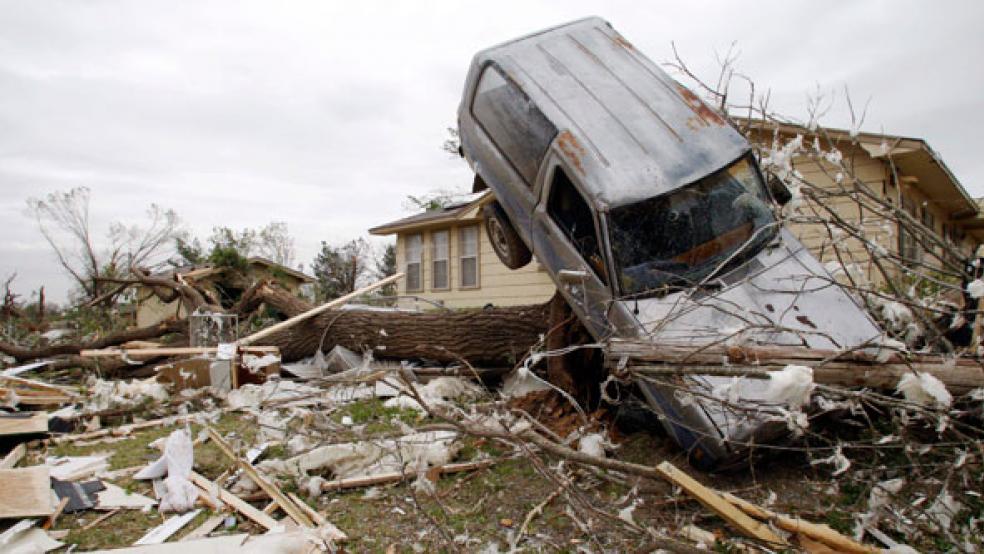A brutal U.S. winter led to an unusually active spring that featured Mother Nature in all her tempestuousness: Floods, torrential downpours and destructive tornadoes.
Now, with hurricane season just around the corner, the rash of extreme weather outbreaks may put disaster preparedness and recovery plans to the test. The threat of natural disaster has raised questions about how prepared companies and governments are for what could be a tough stretch of weather.
Related: What Climate Change Is Really Costing You
This week, the National Oceanic and Atmospheric Administration said it expected 8-13 tropical storms to develop in the Atlantic this year, a below-average number that may only yield one or two major hurricanes. That may come as a relief after Hurricane Sandy walloped the East Coast in 2012.
Still, other forecasters are predicting a sweltering summer, which could create more headaches for wildfires already blazing in the western United States. Additionally, torrid heat also puts strains on power grids, which can trigger mass power outages and force companies and residents to sharply curtail power, water and productivity.
"One of the things we're learning pretty quickly is that Mother Nature is undefeated" when going up against disaster planning, said Dick Jennings, senior vice president of supply chain solutions at transportation giant Ryder.
"Planning for [natural disasters] is becoming more and more the norm," Jennings said in an interview. After Sandy caught both New York and New Jersey flatfooted, "a significant amount of reflection is being driven toward having disaster recovery plans that are robust and larger, and can deal more with the maximum more so than the norm."
Related: Why the Weather Is Our New Favorite Industry
That can make all the difference in the world, because repayment for lost property and business isn't cheap. In a post-mortem report on Hurricane Sandy, Deloitte Touche said assorted power outages, damage and lost business from the storm –which cost somewhere between $30-50 billion—"taught many companies unfortunate lessons about the importance of disaster recovery planning."
According to the Small Business Administration, more than $1 billion in individual payments were made to nearly 200,000 Sandy survivors, many of whom are still struggling years after the fact.
Meanwhile, nearly $8 billion in flood payments were made to insurance policy holders, while the Federal Emergency Management Agency paid out more than $3 billion to repair weather-related damage. At the local level, states like New York and New Jersey –both in the eye of Sandy's wrath – are still trying to untangle who pays for extreme weather, and how much.
In a survey released in April, Chubb Insurance found that natural disaster ranked natural disasters alongside other worries like supply chain failures and data breaches as their top overseas business worries. Of the top 10 business concerns surveyed by Chubb, natural catastrophes ranked number 4.
Steve Hernandez, Chubb's worldwide loss control manager, said that sometimes businesses can get complacent about weather-related risks.
"There's a tendency of businesses to say 'if I made it through before…I can make it through others that occur,'" Hernandez said. "We would say the call to action is greater today than it ever has been."
Businesses and consumers along the Gulf Coast and in the Southeast are among the most vulnerable to natural disasters, Fernandez said, but cautioned that the risks are unpredictable enough that everyone across the country should be prepared.
At the micro level, this means stocking up on simple supplies like water, flashlights and first aid kits; Ryder is a partner of the American Red Cross, which is an emergency first responder. For businesses, power generators and backup facilities are key to riding out possible storms.
Additionally, companies can't necessarily rely on work-from-home solutions. Deloitte's report said telecommuting is impossible if there are mass power outages, or disruptions to the corporation's network. To get around that, the firm says companies might think about farming out work to offices outside the disaster zone, or set up makeshift offices.
Those steps are integral to preventing what Chubb's Fernandez says is the tendency of businesses and governments to "get caught by surprise" by severe weather.
"It may not be a hurricane-type event, it could just be a rain storm," he said.
This article originally appeared in CNBC.
Read more at CNBC:
Even biotechs blame the weather
There's money in bad weather, and it's booming
Flash crash could come at any time: expert




